Role of Lymphatic System and Adaptive Immune Response in Bacterial Infection
VerifiedAdded on 2023/04/20
|12
|2909
|331
AI Summary
This article discusses the role of the lymphatic system and adaptive immune response in responding and resolving bacterial infections. It explains the process of acute inflammation and how the immune system fights against bacteria. The article also includes case studies on cardiovascular changes during exercise and the control of peripheral resistance, as well as a case study on myopia and the diagnosis and treatment options for it.
Contribute Materials
Your contribution can guide someone’s learning journey. Share your
documents today.
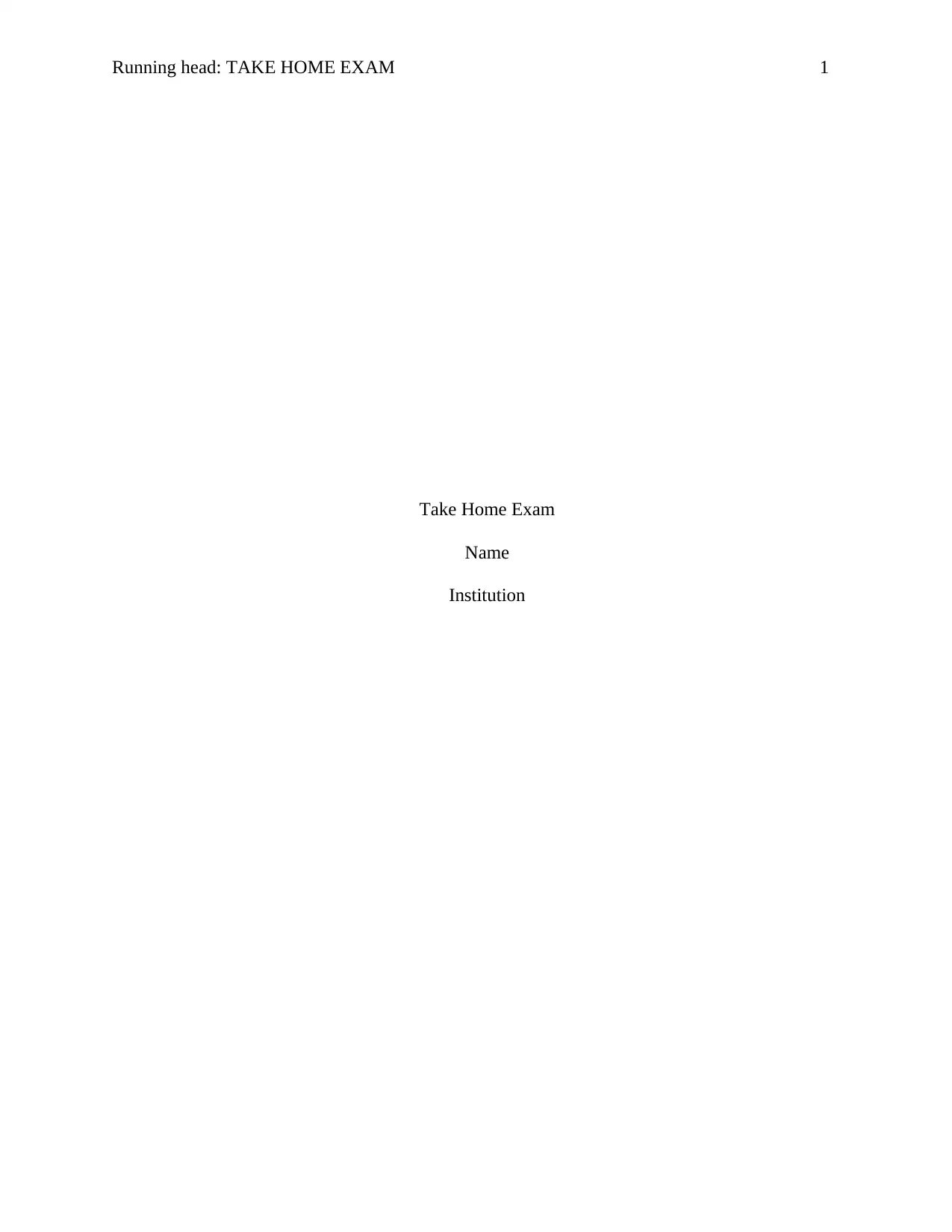
Running head: TAKE HOME EXAM 1
Take Home Exam
Name
Institution
Take Home Exam
Name
Institution
Secure Best Marks with AI Grader
Need help grading? Try our AI Grader for instant feedback on your assignments.
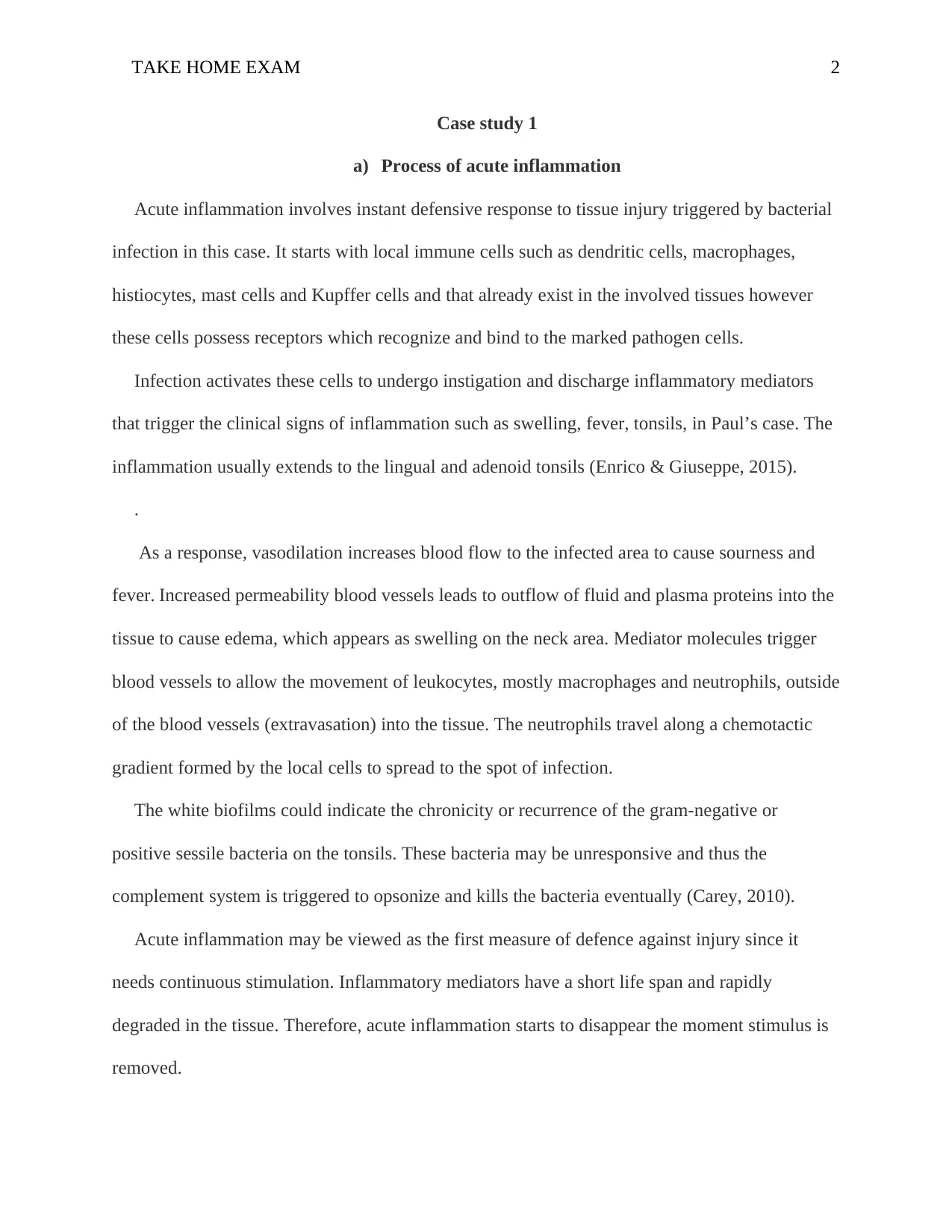
TAKE HOME EXAM 2
Case study 1
a) Process of acute inflammation
Acute inflammation involves instant defensive response to tissue injury triggered by bacterial
infection in this case. It starts with local immune cells such as dendritic cells, macrophages,
histiocytes, mast cells and Kupffer cells and that already exist in the involved tissues however
these cells possess receptors which recognize and bind to the marked pathogen cells.
Infection activates these cells to undergo instigation and discharge inflammatory mediators
that trigger the clinical signs of inflammation such as swelling, fever, tonsils, in Paul’s case. The
inflammation usually extends to the lingual and adenoid tonsils (Enrico & Giuseppe, 2015).
.
As a response, vasodilation increases blood flow to the infected area to cause sourness and
fever. Increased permeability blood vessels leads to outflow of fluid and plasma proteins into the
tissue to cause edema, which appears as swelling on the neck area. Mediator molecules trigger
blood vessels to allow the movement of leukocytes, mostly macrophages and neutrophils, outside
of the blood vessels (extravasation) into the tissue. The neutrophils travel along a chemotactic
gradient formed by the local cells to spread to the spot of infection.
The white biofilms could indicate the chronicity or recurrence of the gram-negative or
positive sessile bacteria on the tonsils. These bacteria may be unresponsive and thus the
complement system is triggered to opsonize and kills the bacteria eventually (Carey, 2010).
Acute inflammation may be viewed as the first measure of defence against injury since it
needs continuous stimulation. Inflammatory mediators have a short life span and rapidly
degraded in the tissue. Therefore, acute inflammation starts to disappear the moment stimulus is
removed.
Case study 1
a) Process of acute inflammation
Acute inflammation involves instant defensive response to tissue injury triggered by bacterial
infection in this case. It starts with local immune cells such as dendritic cells, macrophages,
histiocytes, mast cells and Kupffer cells and that already exist in the involved tissues however
these cells possess receptors which recognize and bind to the marked pathogen cells.
Infection activates these cells to undergo instigation and discharge inflammatory mediators
that trigger the clinical signs of inflammation such as swelling, fever, tonsils, in Paul’s case. The
inflammation usually extends to the lingual and adenoid tonsils (Enrico & Giuseppe, 2015).
.
As a response, vasodilation increases blood flow to the infected area to cause sourness and
fever. Increased permeability blood vessels leads to outflow of fluid and plasma proteins into the
tissue to cause edema, which appears as swelling on the neck area. Mediator molecules trigger
blood vessels to allow the movement of leukocytes, mostly macrophages and neutrophils, outside
of the blood vessels (extravasation) into the tissue. The neutrophils travel along a chemotactic
gradient formed by the local cells to spread to the spot of infection.
The white biofilms could indicate the chronicity or recurrence of the gram-negative or
positive sessile bacteria on the tonsils. These bacteria may be unresponsive and thus the
complement system is triggered to opsonize and kills the bacteria eventually (Carey, 2010).
Acute inflammation may be viewed as the first measure of defence against injury since it
needs continuous stimulation. Inflammatory mediators have a short life span and rapidly
degraded in the tissue. Therefore, acute inflammation starts to disappear the moment stimulus is
removed.
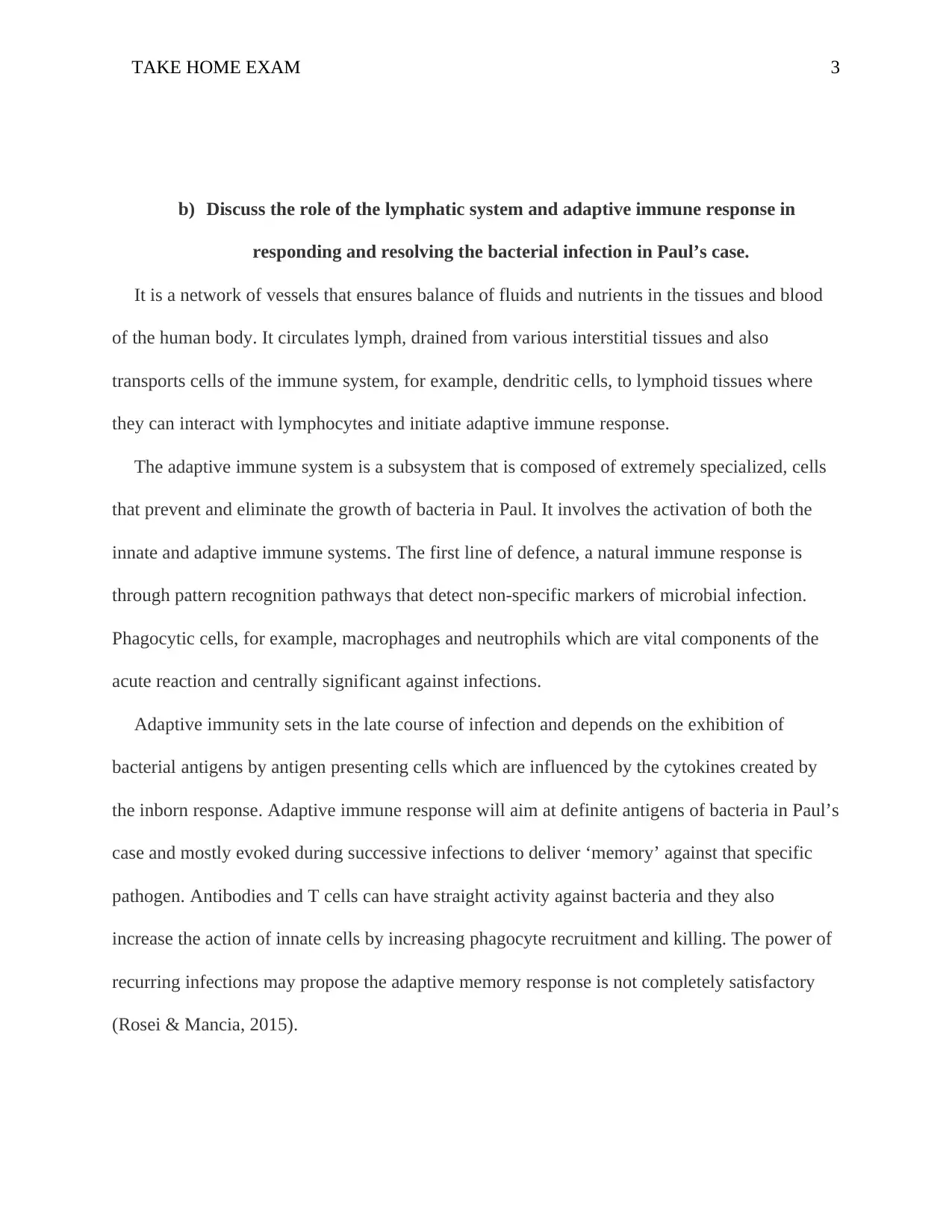
TAKE HOME EXAM 3
b) Discuss the role of the lymphatic system and adaptive immune response in
responding and resolving the bacterial infection in Paul’s case.
It is a network of vessels that ensures balance of fluids and nutrients in the tissues and blood
of the human body. It circulates lymph, drained from various interstitial tissues and also
transports cells of the immune system, for example, dendritic cells, to lymphoid tissues where
they can interact with lymphocytes and initiate adaptive immune response.
The adaptive immune system is a subsystem that is composed of extremely specialized, cells
that prevent and eliminate the growth of bacteria in Paul. It involves the activation of both the
innate and adaptive immune systems. The first line of defence, a natural immune response is
through pattern recognition pathways that detect non-specific markers of microbial infection.
Phagocytic cells, for example, macrophages and neutrophils which are vital components of the
acute reaction and centrally significant against infections.
Adaptive immunity sets in the late course of infection and depends on the exhibition of
bacterial antigens by antigen presenting cells which are influenced by the cytokines created by
the inborn response. Adaptive immune response will aim at definite antigens of bacteria in Paul’s
case and mostly evoked during successive infections to deliver ‘memory’ against that specific
pathogen. Antibodies and T cells can have straight activity against bacteria and they also
increase the action of innate cells by increasing phagocyte recruitment and killing. The power of
recurring infections may propose the adaptive memory response is not completely satisfactory
(Rosei & Mancia, 2015).
b) Discuss the role of the lymphatic system and adaptive immune response in
responding and resolving the bacterial infection in Paul’s case.
It is a network of vessels that ensures balance of fluids and nutrients in the tissues and blood
of the human body. It circulates lymph, drained from various interstitial tissues and also
transports cells of the immune system, for example, dendritic cells, to lymphoid tissues where
they can interact with lymphocytes and initiate adaptive immune response.
The adaptive immune system is a subsystem that is composed of extremely specialized, cells
that prevent and eliminate the growth of bacteria in Paul. It involves the activation of both the
innate and adaptive immune systems. The first line of defence, a natural immune response is
through pattern recognition pathways that detect non-specific markers of microbial infection.
Phagocytic cells, for example, macrophages and neutrophils which are vital components of the
acute reaction and centrally significant against infections.
Adaptive immunity sets in the late course of infection and depends on the exhibition of
bacterial antigens by antigen presenting cells which are influenced by the cytokines created by
the inborn response. Adaptive immune response will aim at definite antigens of bacteria in Paul’s
case and mostly evoked during successive infections to deliver ‘memory’ against that specific
pathogen. Antibodies and T cells can have straight activity against bacteria and they also
increase the action of innate cells by increasing phagocyte recruitment and killing. The power of
recurring infections may propose the adaptive memory response is not completely satisfactory
(Rosei & Mancia, 2015).
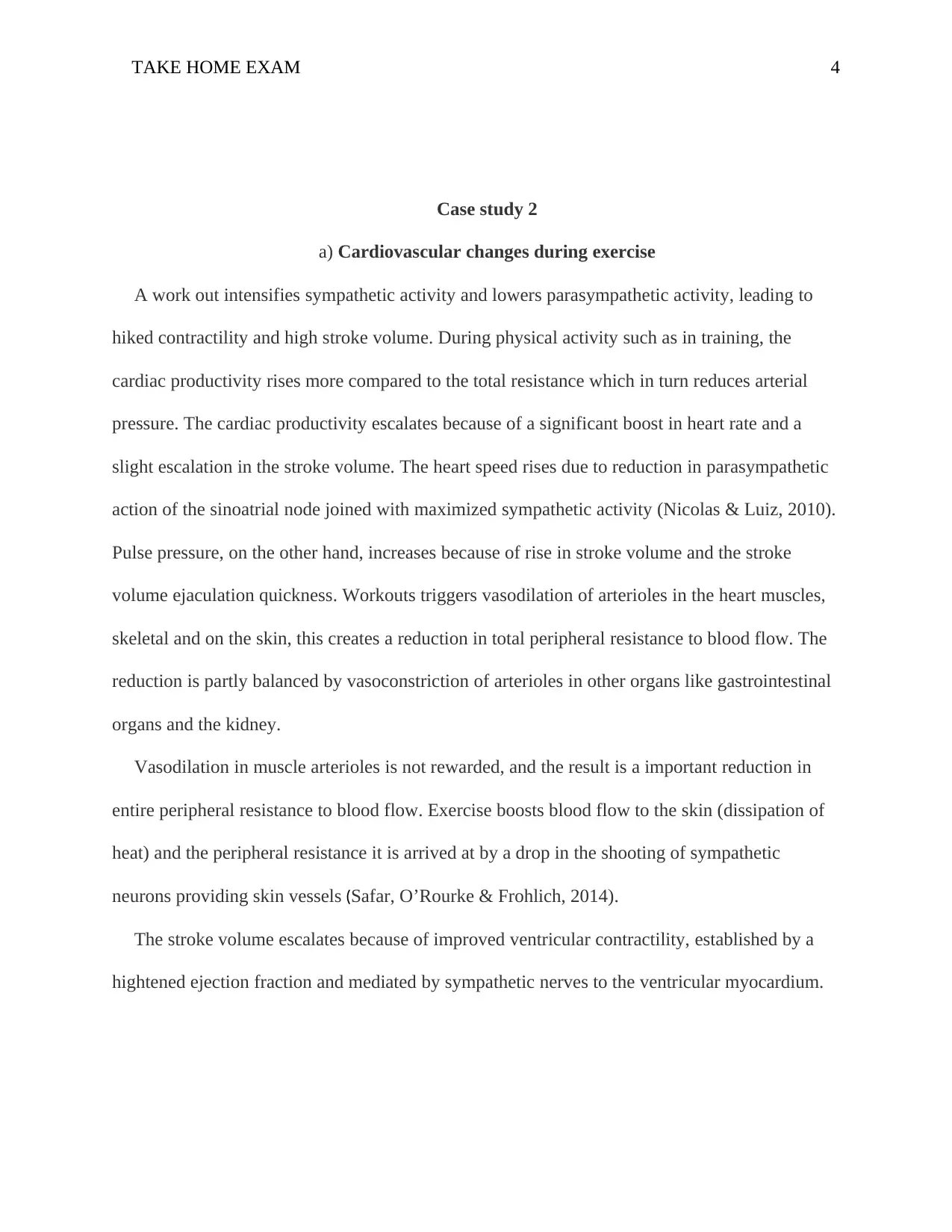
TAKE HOME EXAM 4
Case study 2
a) Cardiovascular changes during exercise
A work out intensifies sympathetic activity and lowers parasympathetic activity, leading to
hiked contractility and high stroke volume. During physical activity such as in training, the
cardiac productivity rises more compared to the total resistance which in turn reduces arterial
pressure. The cardiac productivity escalates because of a significant boost in heart rate and a
slight escalation in the stroke volume. The heart speed rises due to reduction in parasympathetic
action of the sinoatrial node joined with maximized sympathetic activity (Nicolas & Luiz, 2010).
Pulse pressure, on the other hand, increases because of rise in stroke volume and the stroke
volume ejaculation quickness. Workouts triggers vasodilation of arterioles in the heart muscles,
skeletal and on the skin, this creates a reduction in total peripheral resistance to blood flow. The
reduction is partly balanced by vasoconstriction of arterioles in other organs like gastrointestinal
organs and the kidney.
Vasodilation in muscle arterioles is not rewarded, and the result is a important reduction in
entire peripheral resistance to blood flow. Exercise boosts blood flow to the skin (dissipation of
heat) and the peripheral resistance it is arrived at by a drop in the shooting of sympathetic
neurons providing skin vessels (Safar, O’Rourke & Frohlich, 2014).
The stroke volume escalates because of improved ventricular contractility, established by a
hightened ejection fraction and mediated by sympathetic nerves to the ventricular myocardium.
Case study 2
a) Cardiovascular changes during exercise
A work out intensifies sympathetic activity and lowers parasympathetic activity, leading to
hiked contractility and high stroke volume. During physical activity such as in training, the
cardiac productivity rises more compared to the total resistance which in turn reduces arterial
pressure. The cardiac productivity escalates because of a significant boost in heart rate and a
slight escalation in the stroke volume. The heart speed rises due to reduction in parasympathetic
action of the sinoatrial node joined with maximized sympathetic activity (Nicolas & Luiz, 2010).
Pulse pressure, on the other hand, increases because of rise in stroke volume and the stroke
volume ejaculation quickness. Workouts triggers vasodilation of arterioles in the heart muscles,
skeletal and on the skin, this creates a reduction in total peripheral resistance to blood flow. The
reduction is partly balanced by vasoconstriction of arterioles in other organs like gastrointestinal
organs and the kidney.
Vasodilation in muscle arterioles is not rewarded, and the result is a important reduction in
entire peripheral resistance to blood flow. Exercise boosts blood flow to the skin (dissipation of
heat) and the peripheral resistance it is arrived at by a drop in the shooting of sympathetic
neurons providing skin vessels (Safar, O’Rourke & Frohlich, 2014).
The stroke volume escalates because of improved ventricular contractility, established by a
hightened ejection fraction and mediated by sympathetic nerves to the ventricular myocardium.
Secure Best Marks with AI Grader
Need help grading? Try our AI Grader for instant feedback on your assignments.
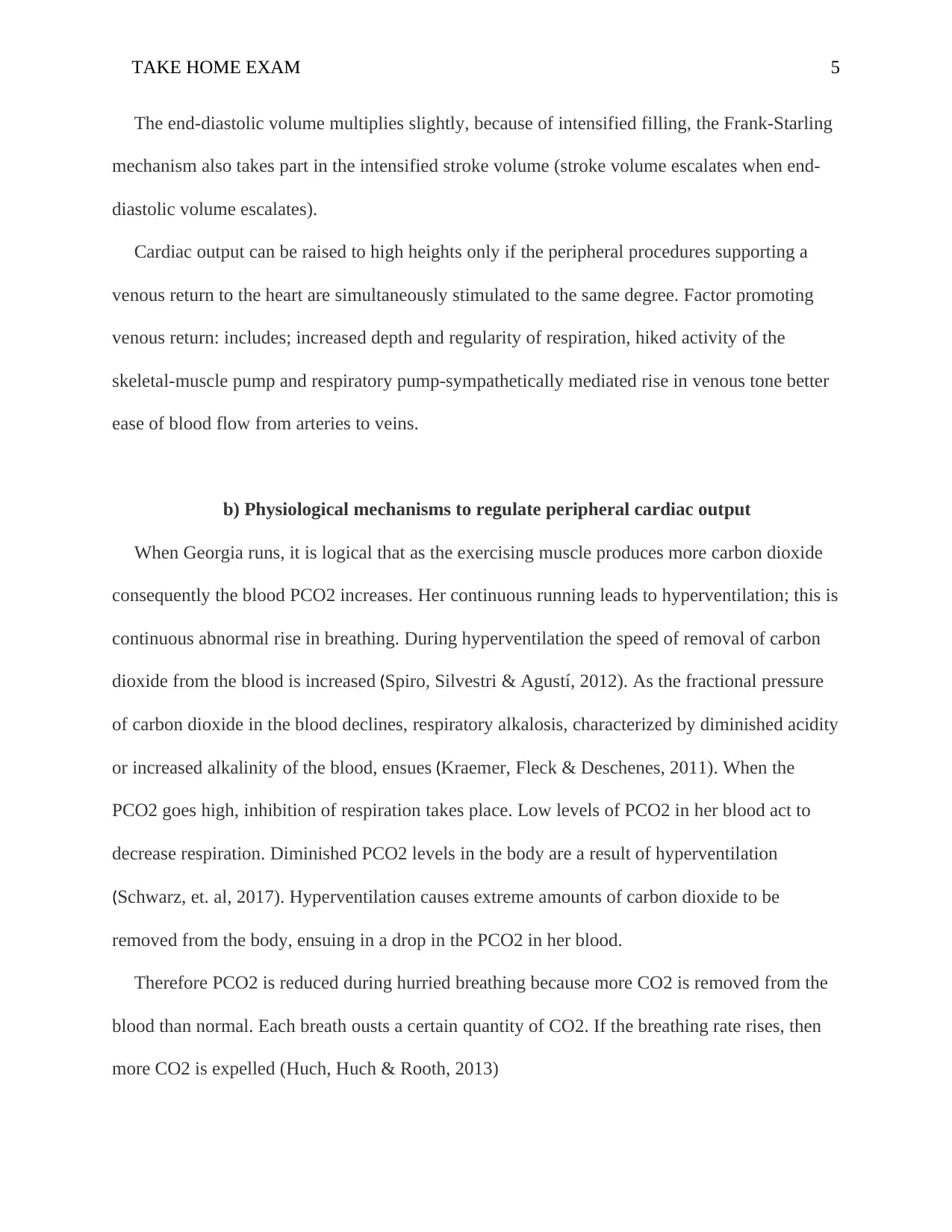
TAKE HOME EXAM 5
The end-diastolic volume multiplies slightly, because of intensified filling, the Frank-Starling
mechanism also takes part in the intensified stroke volume (stroke volume escalates when end-
diastolic volume escalates).
Cardiac output can be raised to high heights only if the peripheral procedures supporting a
venous return to the heart are simultaneously stimulated to the same degree. Factor promoting
venous return: includes; increased depth and regularity of respiration, hiked activity of the
skeletal-muscle pump and respiratory pump-sympathetically mediated rise in venous tone better
ease of blood flow from arteries to veins.
b) Physiological mechanisms to regulate peripheral cardiac output
When Georgia runs, it is logical that as the exercising muscle produces more carbon dioxide
consequently the blood PCO2 increases. Her continuous running leads to hyperventilation; this is
continuous abnormal rise in breathing. During hyperventilation the speed of removal of carbon
dioxide from the blood is increased (Spiro, Silvestri & Agustí, 2012). As the fractional pressure
of carbon dioxide in the blood declines, respiratory alkalosis, characterized by diminished acidity
or increased alkalinity of the blood, ensues (Kraemer, Fleck & Deschenes, 2011). When the
PCO2 goes high, inhibition of respiration takes place. Low levels of PCO2 in her blood act to
decrease respiration. Diminished PCO2 levels in the body are a result of hyperventilation
(Schwarz, et. al, 2017). Hyperventilation causes extreme amounts of carbon dioxide to be
removed from the body, ensuing in a drop in the PCO2 in her blood.
Therefore PCO2 is reduced during hurried breathing because more CO2 is removed from the
blood than normal. Each breath ousts a certain quantity of CO2. If the breathing rate rises, then
more CO2 is expelled (Huch, Huch & Rooth, 2013)
The end-diastolic volume multiplies slightly, because of intensified filling, the Frank-Starling
mechanism also takes part in the intensified stroke volume (stroke volume escalates when end-
diastolic volume escalates).
Cardiac output can be raised to high heights only if the peripheral procedures supporting a
venous return to the heart are simultaneously stimulated to the same degree. Factor promoting
venous return: includes; increased depth and regularity of respiration, hiked activity of the
skeletal-muscle pump and respiratory pump-sympathetically mediated rise in venous tone better
ease of blood flow from arteries to veins.
b) Physiological mechanisms to regulate peripheral cardiac output
When Georgia runs, it is logical that as the exercising muscle produces more carbon dioxide
consequently the blood PCO2 increases. Her continuous running leads to hyperventilation; this is
continuous abnormal rise in breathing. During hyperventilation the speed of removal of carbon
dioxide from the blood is increased (Spiro, Silvestri & Agustí, 2012). As the fractional pressure
of carbon dioxide in the blood declines, respiratory alkalosis, characterized by diminished acidity
or increased alkalinity of the blood, ensues (Kraemer, Fleck & Deschenes, 2011). When the
PCO2 goes high, inhibition of respiration takes place. Low levels of PCO2 in her blood act to
decrease respiration. Diminished PCO2 levels in the body are a result of hyperventilation
(Schwarz, et. al, 2017). Hyperventilation causes extreme amounts of carbon dioxide to be
removed from the body, ensuing in a drop in the PCO2 in her blood.
Therefore PCO2 is reduced during hurried breathing because more CO2 is removed from the
blood than normal. Each breath ousts a certain quantity of CO2. If the breathing rate rises, then
more CO2 is expelled (Huch, Huch & Rooth, 2013)
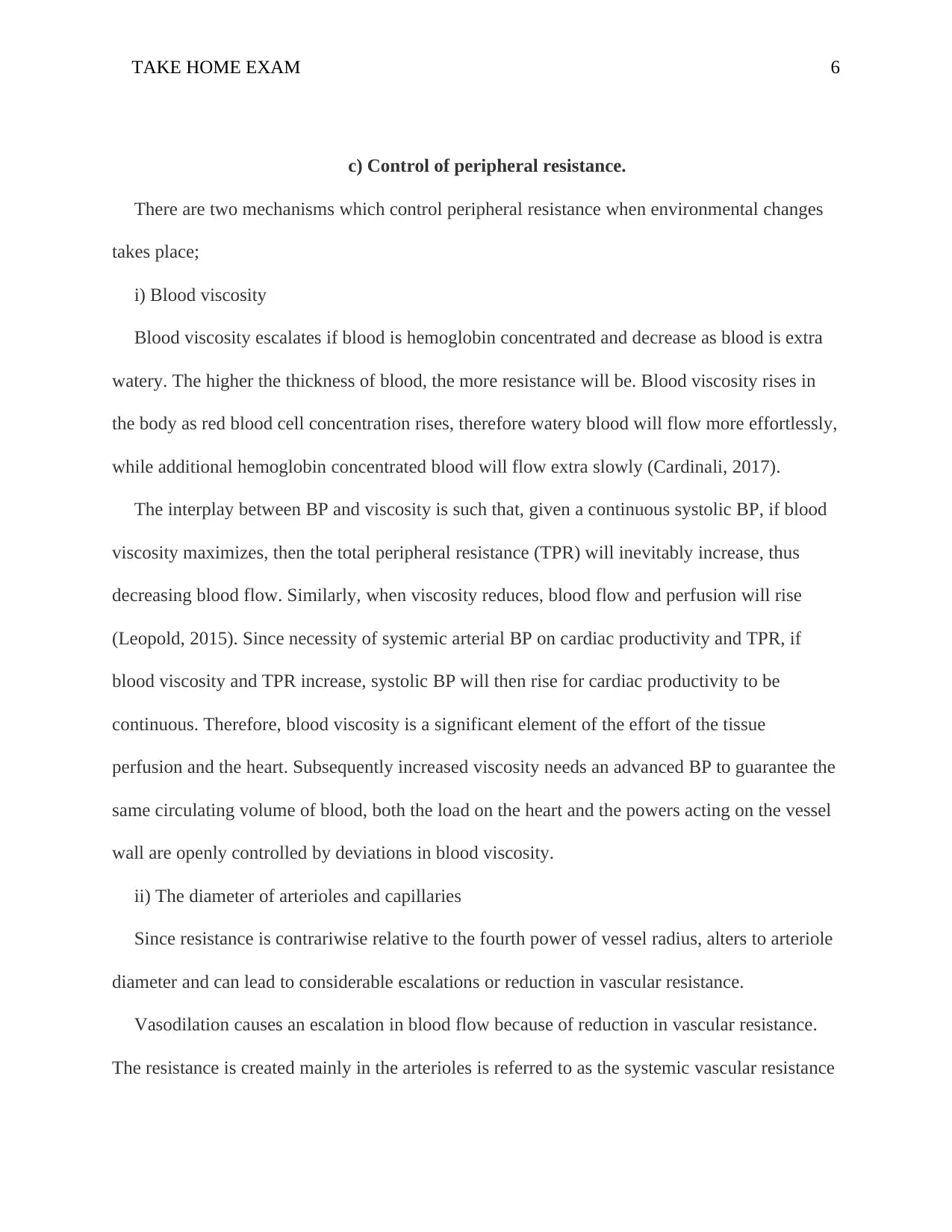
TAKE HOME EXAM 6
c) Control of peripheral resistance.
There are two mechanisms which control peripheral resistance when environmental changes
takes place;
i) Blood viscosity
Blood viscosity escalates if blood is hemoglobin concentrated and decrease as blood is extra
watery. The higher the thickness of blood, the more resistance will be. Blood viscosity rises in
the body as red blood cell concentration rises, therefore watery blood will flow more effortlessly,
while additional hemoglobin concentrated blood will flow extra slowly (Cardinali, 2017).
The interplay between BP and viscosity is such that, given a continuous systolic BP, if blood
viscosity maximizes, then the total peripheral resistance (TPR) will inevitably increase, thus
decreasing blood flow. Similarly, when viscosity reduces, blood flow and perfusion will rise
(Leopold, 2015). Since necessity of systemic arterial BP on cardiac productivity and TPR, if
blood viscosity and TPR increase, systolic BP will then rise for cardiac productivity to be
continuous. Therefore, blood viscosity is a significant element of the effort of the tissue
perfusion and the heart. Subsequently increased viscosity needs an advanced BP to guarantee the
same circulating volume of blood, both the load on the heart and the powers acting on the vessel
wall are openly controlled by deviations in blood viscosity.
ii) The diameter of arterioles and capillaries
Since resistance is contrariwise relative to the fourth power of vessel radius, alters to arteriole
diameter and can lead to considerable escalations or reduction in vascular resistance.
Vasodilation causes an escalation in blood flow because of reduction in vascular resistance.
The resistance is created mainly in the arterioles is referred to as the systemic vascular resistance
c) Control of peripheral resistance.
There are two mechanisms which control peripheral resistance when environmental changes
takes place;
i) Blood viscosity
Blood viscosity escalates if blood is hemoglobin concentrated and decrease as blood is extra
watery. The higher the thickness of blood, the more resistance will be. Blood viscosity rises in
the body as red blood cell concentration rises, therefore watery blood will flow more effortlessly,
while additional hemoglobin concentrated blood will flow extra slowly (Cardinali, 2017).
The interplay between BP and viscosity is such that, given a continuous systolic BP, if blood
viscosity maximizes, then the total peripheral resistance (TPR) will inevitably increase, thus
decreasing blood flow. Similarly, when viscosity reduces, blood flow and perfusion will rise
(Leopold, 2015). Since necessity of systemic arterial BP on cardiac productivity and TPR, if
blood viscosity and TPR increase, systolic BP will then rise for cardiac productivity to be
continuous. Therefore, blood viscosity is a significant element of the effort of the tissue
perfusion and the heart. Subsequently increased viscosity needs an advanced BP to guarantee the
same circulating volume of blood, both the load on the heart and the powers acting on the vessel
wall are openly controlled by deviations in blood viscosity.
ii) The diameter of arterioles and capillaries
Since resistance is contrariwise relative to the fourth power of vessel radius, alters to arteriole
diameter and can lead to considerable escalations or reduction in vascular resistance.
Vasodilation causes an escalation in blood flow because of reduction in vascular resistance.
The resistance is created mainly in the arterioles is referred to as the systemic vascular resistance
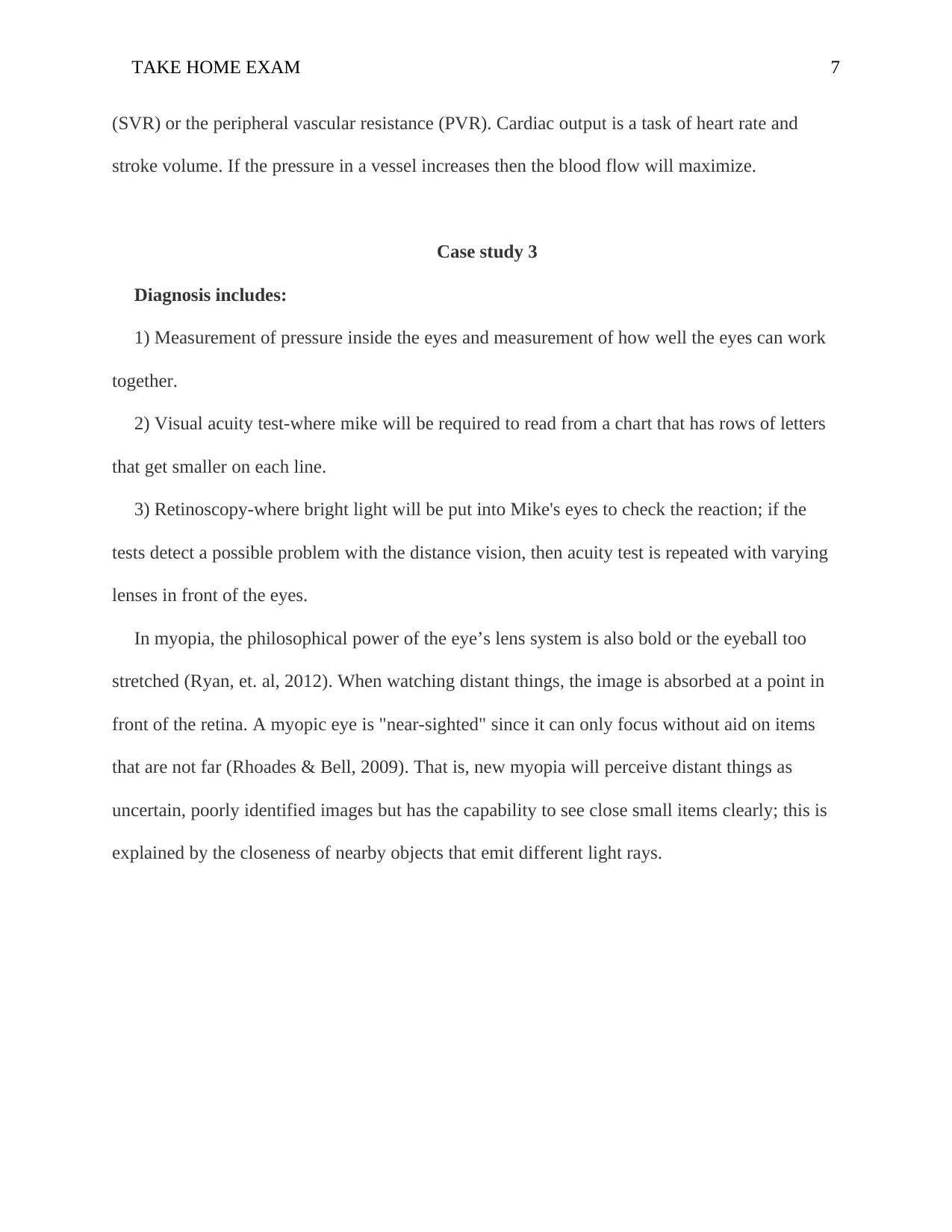
TAKE HOME EXAM 7
(SVR) or the peripheral vascular resistance (PVR). Cardiac output is a task of heart rate and
stroke volume. If the pressure in a vessel increases then the blood flow will maximize.
Case study 3
Diagnosis includes:
1) Measurement of pressure inside the eyes and measurement of how well the eyes can work
together.
2) Visual acuity test-where mike will be required to read from a chart that has rows of letters
that get smaller on each line.
3) Retinoscopy-where bright light will be put into Mike's eyes to check the reaction; if the
tests detect a possible problem with the distance vision, then acuity test is repeated with varying
lenses in front of the eyes.
In myopia, the philosophical power of the eye’s lens system is also bold or the eyeball too
stretched (Ryan, et. al, 2012). When watching distant things, the image is absorbed at a point in
front of the retina. A myopic eye is "near-sighted" since it can only focus without aid on items
that are not far (Rhoades & Bell, 2009). That is, new myopia will perceive distant things as
uncertain, poorly identified images but has the capability to see close small items clearly; this is
explained by the closeness of nearby objects that emit different light rays.
(SVR) or the peripheral vascular resistance (PVR). Cardiac output is a task of heart rate and
stroke volume. If the pressure in a vessel increases then the blood flow will maximize.
Case study 3
Diagnosis includes:
1) Measurement of pressure inside the eyes and measurement of how well the eyes can work
together.
2) Visual acuity test-where mike will be required to read from a chart that has rows of letters
that get smaller on each line.
3) Retinoscopy-where bright light will be put into Mike's eyes to check the reaction; if the
tests detect a possible problem with the distance vision, then acuity test is repeated with varying
lenses in front of the eyes.
In myopia, the philosophical power of the eye’s lens system is also bold or the eyeball too
stretched (Ryan, et. al, 2012). When watching distant things, the image is absorbed at a point in
front of the retina. A myopic eye is "near-sighted" since it can only focus without aid on items
that are not far (Rhoades & Bell, 2009). That is, new myopia will perceive distant things as
uncertain, poorly identified images but has the capability to see close small items clearly; this is
explained by the closeness of nearby objects that emit different light rays.
Paraphrase This Document
Need a fresh take? Get an instant paraphrase of this document with our AI Paraphraser
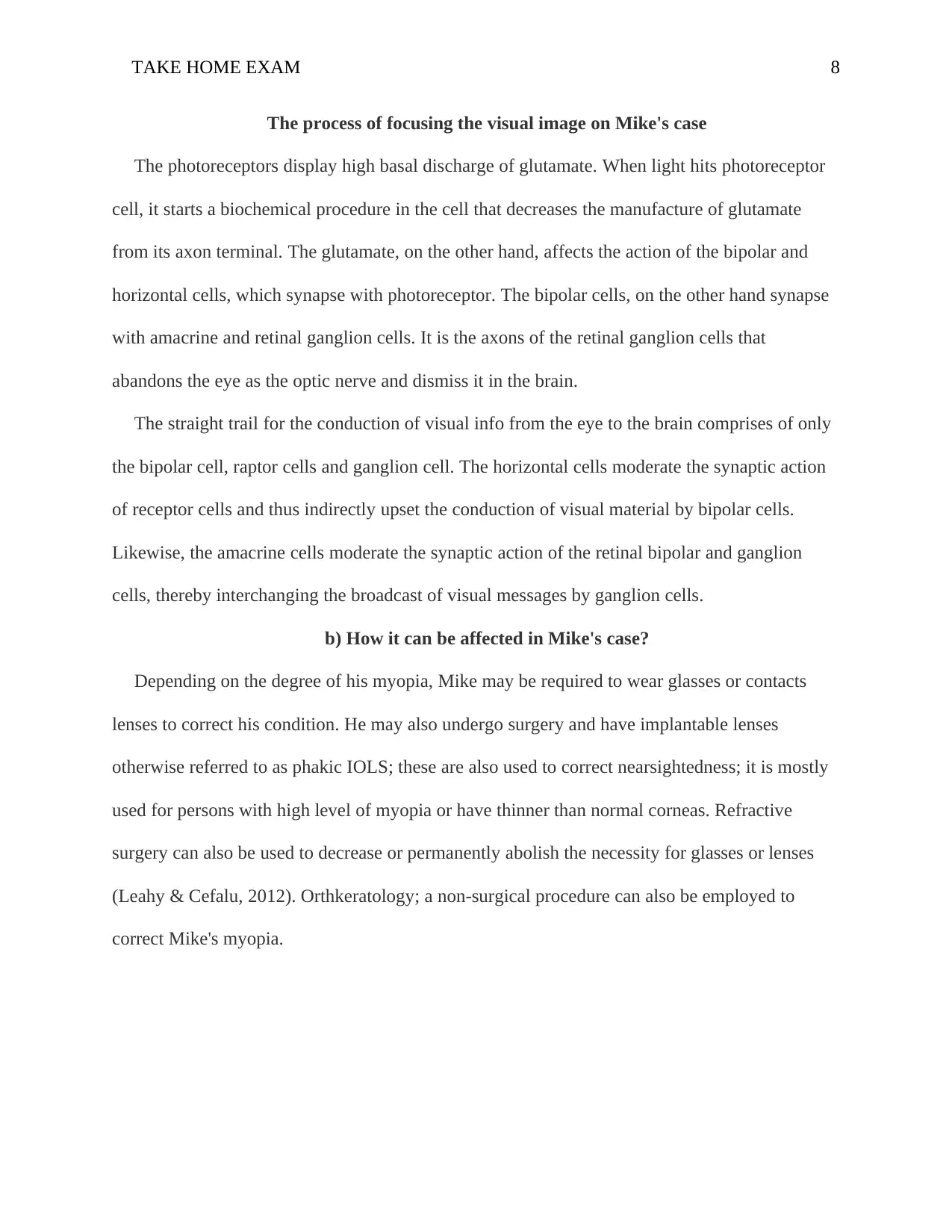
TAKE HOME EXAM 8
The process of focusing the visual image on Mike's case
The photoreceptors display high basal discharge of glutamate. When light hits photoreceptor
cell, it starts a biochemical procedure in the cell that decreases the manufacture of glutamate
from its axon terminal. The glutamate, on the other hand, affects the action of the bipolar and
horizontal cells, which synapse with photoreceptor. The bipolar cells, on the other hand synapse
with amacrine and retinal ganglion cells. It is the axons of the retinal ganglion cells that
abandons the eye as the optic nerve and dismiss it in the brain.
The straight trail for the conduction of visual info from the eye to the brain comprises of only
the bipolar cell, raptor cells and ganglion cell. The horizontal cells moderate the synaptic action
of receptor cells and thus indirectly upset the conduction of visual material by bipolar cells.
Likewise, the amacrine cells moderate the synaptic action of the retinal bipolar and ganglion
cells, thereby interchanging the broadcast of visual messages by ganglion cells.
b) How it can be affected in Mike's case?
Depending on the degree of his myopia, Mike may be required to wear glasses or contacts
lenses to correct his condition. He may also undergo surgery and have implantable lenses
otherwise referred to as phakic IOLS; these are also used to correct nearsightedness; it is mostly
used for persons with high level of myopia or have thinner than normal corneas. Refractive
surgery can also be used to decrease or permanently abolish the necessity for glasses or lenses
(Leahy & Cefalu, 2012). Orthkeratology; a non-surgical procedure can also be employed to
correct Mike's myopia.
The process of focusing the visual image on Mike's case
The photoreceptors display high basal discharge of glutamate. When light hits photoreceptor
cell, it starts a biochemical procedure in the cell that decreases the manufacture of glutamate
from its axon terminal. The glutamate, on the other hand, affects the action of the bipolar and
horizontal cells, which synapse with photoreceptor. The bipolar cells, on the other hand synapse
with amacrine and retinal ganglion cells. It is the axons of the retinal ganglion cells that
abandons the eye as the optic nerve and dismiss it in the brain.
The straight trail for the conduction of visual info from the eye to the brain comprises of only
the bipolar cell, raptor cells and ganglion cell. The horizontal cells moderate the synaptic action
of receptor cells and thus indirectly upset the conduction of visual material by bipolar cells.
Likewise, the amacrine cells moderate the synaptic action of the retinal bipolar and ganglion
cells, thereby interchanging the broadcast of visual messages by ganglion cells.
b) How it can be affected in Mike's case?
Depending on the degree of his myopia, Mike may be required to wear glasses or contacts
lenses to correct his condition. He may also undergo surgery and have implantable lenses
otherwise referred to as phakic IOLS; these are also used to correct nearsightedness; it is mostly
used for persons with high level of myopia or have thinner than normal corneas. Refractive
surgery can also be used to decrease or permanently abolish the necessity for glasses or lenses
(Leahy & Cefalu, 2012). Orthkeratology; a non-surgical procedure can also be employed to
correct Mike's myopia.
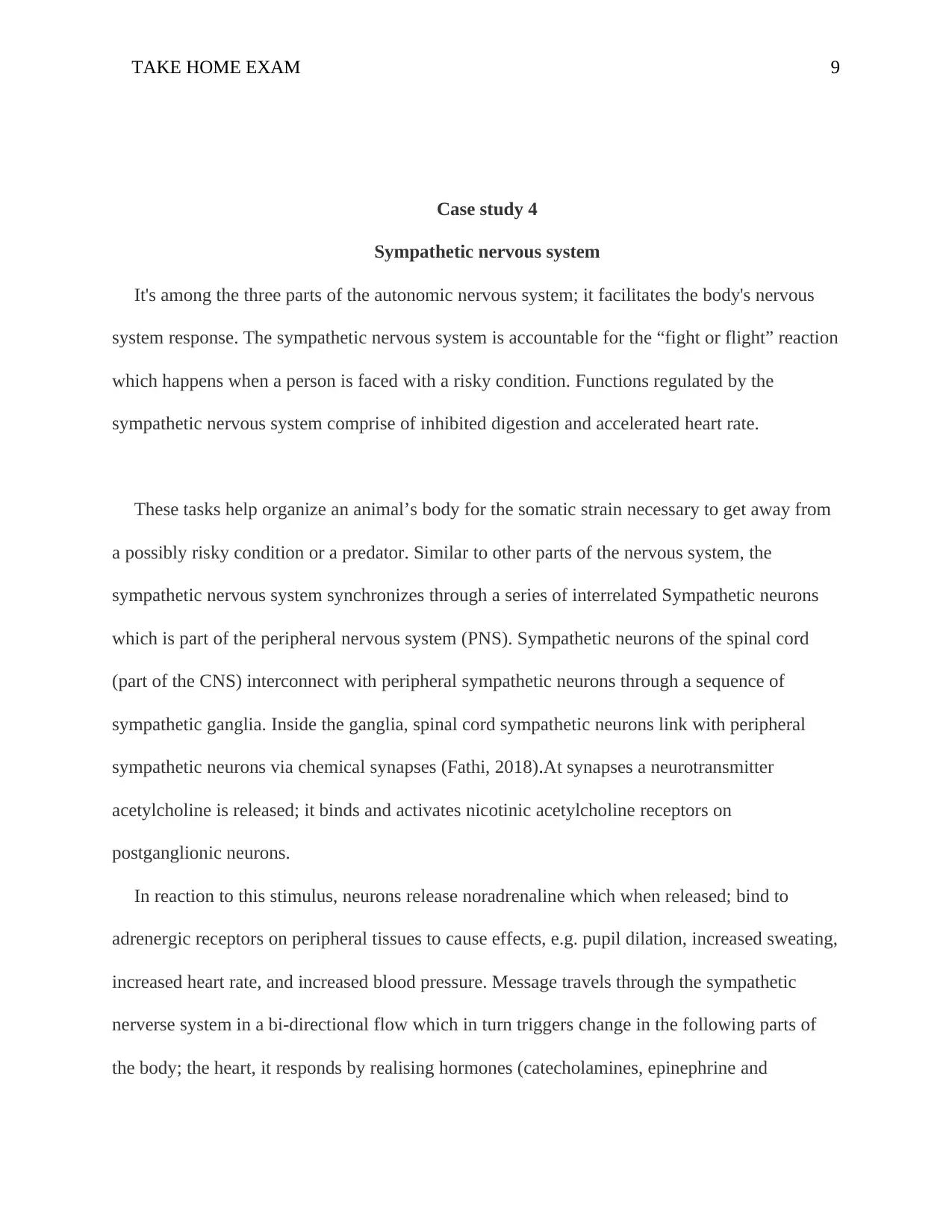
TAKE HOME EXAM 9
Case study 4
Sympathetic nervous system
It's among the three parts of the autonomic nervous system; it facilitates the body's nervous
system response. The sympathetic nervous system is accountable for the “fight or flight” reaction
which happens when a person is faced with a risky condition. Functions regulated by the
sympathetic nervous system comprise of inhibited digestion and accelerated heart rate.
These tasks help organize an animal’s body for the somatic strain necessary to get away from
a possibly risky condition or a predator. Similar to other parts of the nervous system, the
sympathetic nervous system synchronizes through a series of interrelated Sympathetic neurons
which is part of the peripheral nervous system (PNS). Sympathetic neurons of the spinal cord
(part of the CNS) interconnect with peripheral sympathetic neurons through a sequence of
sympathetic ganglia. Inside the ganglia, spinal cord sympathetic neurons link with peripheral
sympathetic neurons via chemical synapses (Fathi, 2018).At synapses a neurotransmitter
acetylcholine is released; it binds and activates nicotinic acetylcholine receptors on
postganglionic neurons.
In reaction to this stimulus, neurons release noradrenaline which when released; bind to
adrenergic receptors on peripheral tissues to cause effects, e.g. pupil dilation, increased sweating,
increased heart rate, and increased blood pressure. Message travels through the sympathetic
nerverse system in a bi-directional flow which in turn triggers change in the following parts of
the body; the heart, it responds by realising hormones (catecholamines, epinephrine and
Case study 4
Sympathetic nervous system
It's among the three parts of the autonomic nervous system; it facilitates the body's nervous
system response. The sympathetic nervous system is accountable for the “fight or flight” reaction
which happens when a person is faced with a risky condition. Functions regulated by the
sympathetic nervous system comprise of inhibited digestion and accelerated heart rate.
These tasks help organize an animal’s body for the somatic strain necessary to get away from
a possibly risky condition or a predator. Similar to other parts of the nervous system, the
sympathetic nervous system synchronizes through a series of interrelated Sympathetic neurons
which is part of the peripheral nervous system (PNS). Sympathetic neurons of the spinal cord
(part of the CNS) interconnect with peripheral sympathetic neurons through a sequence of
sympathetic ganglia. Inside the ganglia, spinal cord sympathetic neurons link with peripheral
sympathetic neurons via chemical synapses (Fathi, 2018).At synapses a neurotransmitter
acetylcholine is released; it binds and activates nicotinic acetylcholine receptors on
postganglionic neurons.
In reaction to this stimulus, neurons release noradrenaline which when released; bind to
adrenergic receptors on peripheral tissues to cause effects, e.g. pupil dilation, increased sweating,
increased heart rate, and increased blood pressure. Message travels through the sympathetic
nerverse system in a bi-directional flow which in turn triggers change in the following parts of
the body; the heart, it responds by realising hormones (catecholamines, epinephrine and
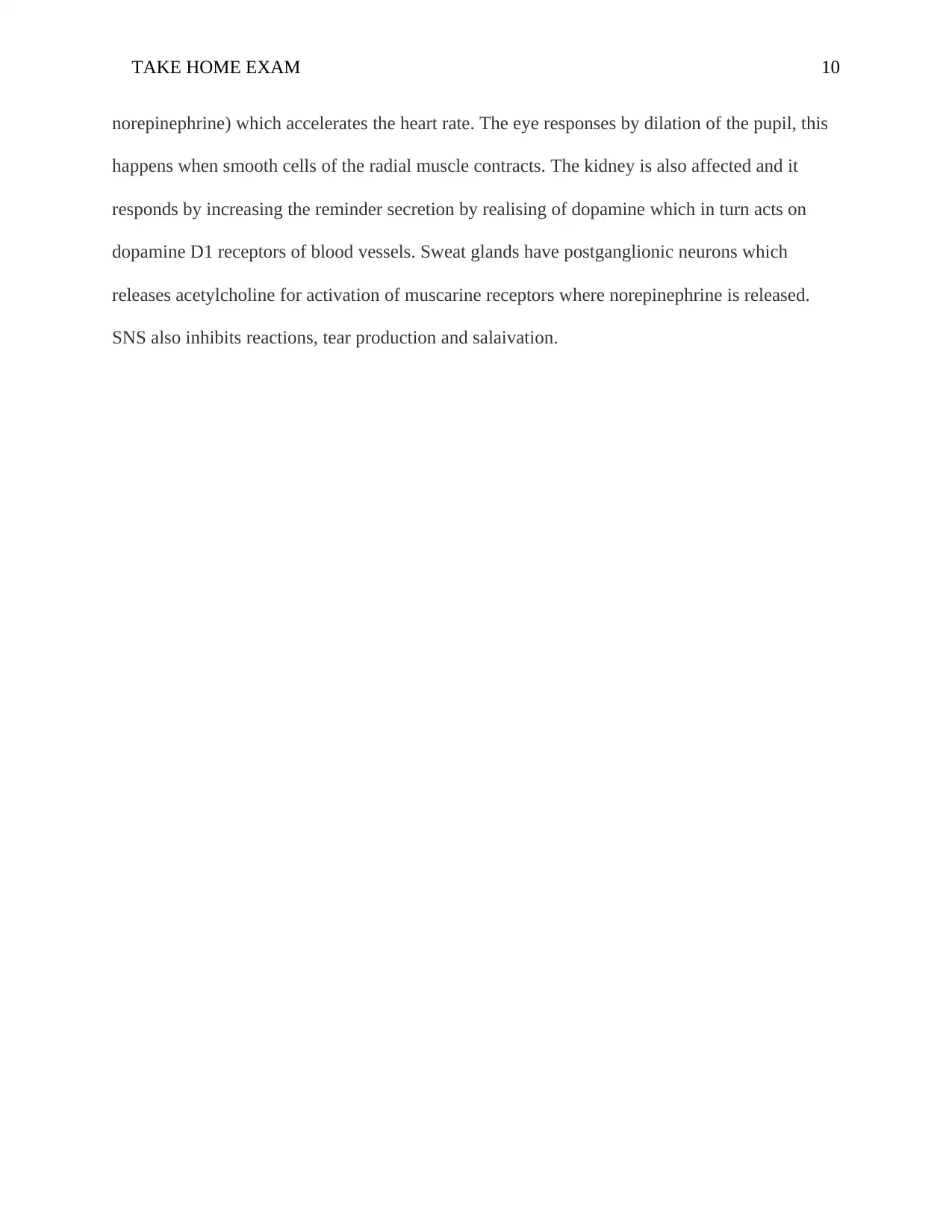
TAKE HOME EXAM 10
norepinephrine) which accelerates the heart rate. The eye responses by dilation of the pupil, this
happens when smooth cells of the radial muscle contracts. The kidney is also affected and it
responds by increasing the reminder secretion by realising of dopamine which in turn acts on
dopamine D1 receptors of blood vessels. Sweat glands have postganglionic neurons which
releases acetylcholine for activation of muscarine receptors where norepinephrine is released.
SNS also inhibits reactions, tear production and salaivation.
norepinephrine) which accelerates the heart rate. The eye responses by dilation of the pupil, this
happens when smooth cells of the radial muscle contracts. The kidney is also affected and it
responds by increasing the reminder secretion by realising of dopamine which in turn acts on
dopamine D1 receptors of blood vessels. Sweat glands have postganglionic neurons which
releases acetylcholine for activation of muscarine receptors where norepinephrine is released.
SNS also inhibits reactions, tear production and salaivation.
Secure Best Marks with AI Grader
Need help grading? Try our AI Grader for instant feedback on your assignments.
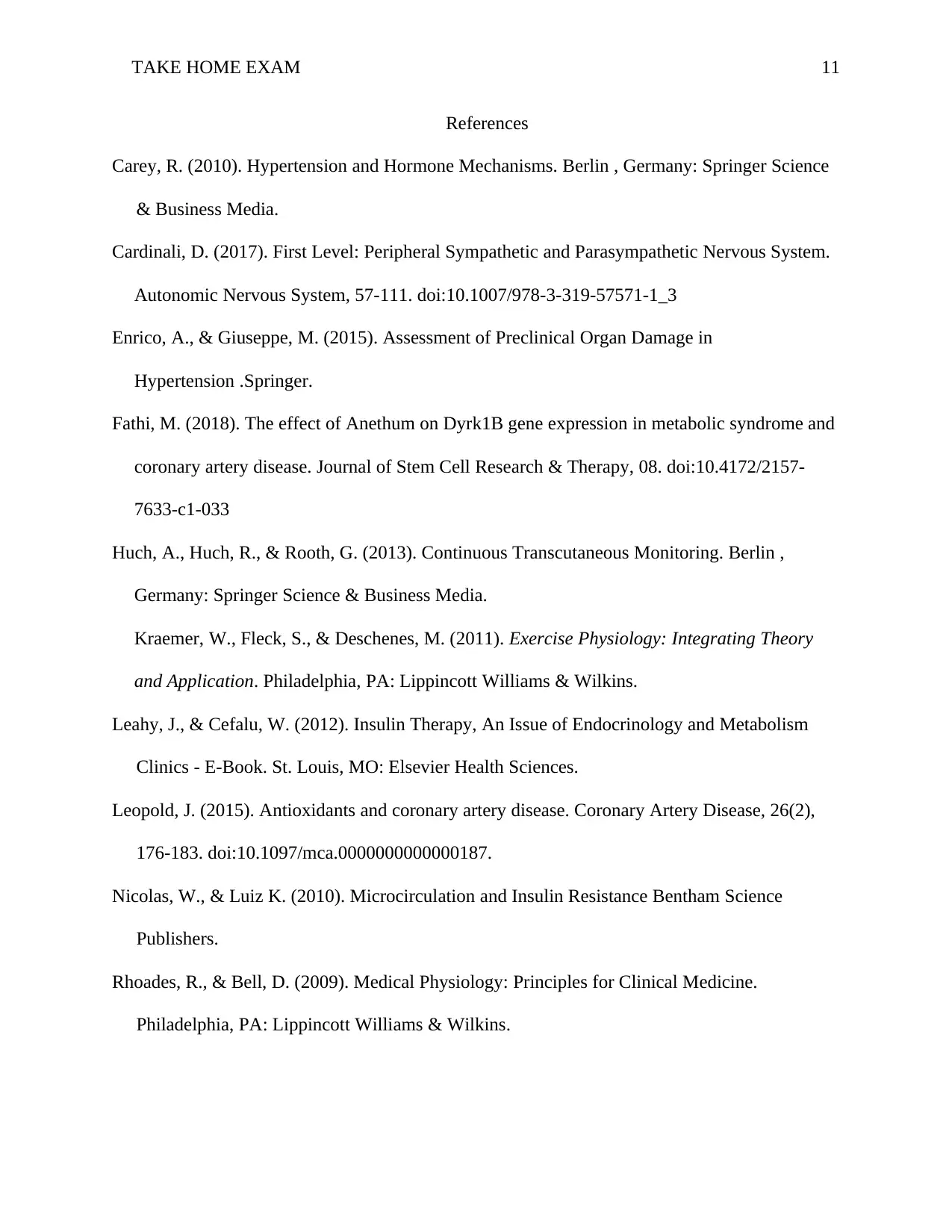
TAKE HOME EXAM 11
References
Carey, R. (2010). Hypertension and Hormone Mechanisms. Berlin , Germany: Springer Science
& Business Media.
Cardinali, D. (2017). First Level: Peripheral Sympathetic and Parasympathetic Nervous System.
Autonomic Nervous System, 57-111. doi:10.1007/978-3-319-57571-1_3
Enrico, A., & Giuseppe, M. (2015). Assessment of Preclinical Organ Damage in
Hypertension .Springer.
Fathi, M. (2018). The effect of Anethum on Dyrk1B gene expression in metabolic syndrome and
coronary artery disease. Journal of Stem Cell Research & Therapy, 08. doi:10.4172/2157-
7633-c1-033
Huch, A., Huch, R., & Rooth, G. (2013). Continuous Transcutaneous Monitoring. Berlin ,
Germany: Springer Science & Business Media.
Kraemer, W., Fleck, S., & Deschenes, M. (2011). Exercise Physiology: Integrating Theory
and Application. Philadelphia, PA: Lippincott Williams & Wilkins.
Leahy, J., & Cefalu, W. (2012). Insulin Therapy, An Issue of Endocrinology and Metabolism
Clinics - E-Book. St. Louis, MO: Elsevier Health Sciences.
Leopold, J. (2015). Antioxidants and coronary artery disease. Coronary Artery Disease, 26(2),
176-183. doi:10.1097/mca.0000000000000187.
Nicolas, W., & Luiz K. (2010). Microcirculation and Insulin Resistance Bentham Science
Publishers.
Rhoades, R., & Bell, D. (2009). Medical Physiology: Principles for Clinical Medicine.
Philadelphia, PA: Lippincott Williams & Wilkins.
References
Carey, R. (2010). Hypertension and Hormone Mechanisms. Berlin , Germany: Springer Science
& Business Media.
Cardinali, D. (2017). First Level: Peripheral Sympathetic and Parasympathetic Nervous System.
Autonomic Nervous System, 57-111. doi:10.1007/978-3-319-57571-1_3
Enrico, A., & Giuseppe, M. (2015). Assessment of Preclinical Organ Damage in
Hypertension .Springer.
Fathi, M. (2018). The effect of Anethum on Dyrk1B gene expression in metabolic syndrome and
coronary artery disease. Journal of Stem Cell Research & Therapy, 08. doi:10.4172/2157-
7633-c1-033
Huch, A., Huch, R., & Rooth, G. (2013). Continuous Transcutaneous Monitoring. Berlin ,
Germany: Springer Science & Business Media.
Kraemer, W., Fleck, S., & Deschenes, M. (2011). Exercise Physiology: Integrating Theory
and Application. Philadelphia, PA: Lippincott Williams & Wilkins.
Leahy, J., & Cefalu, W. (2012). Insulin Therapy, An Issue of Endocrinology and Metabolism
Clinics - E-Book. St. Louis, MO: Elsevier Health Sciences.
Leopold, J. (2015). Antioxidants and coronary artery disease. Coronary Artery Disease, 26(2),
176-183. doi:10.1097/mca.0000000000000187.
Nicolas, W., & Luiz K. (2010). Microcirculation and Insulin Resistance Bentham Science
Publishers.
Rhoades, R., & Bell, D. (2009). Medical Physiology: Principles for Clinical Medicine.
Philadelphia, PA: Lippincott Williams & Wilkins.
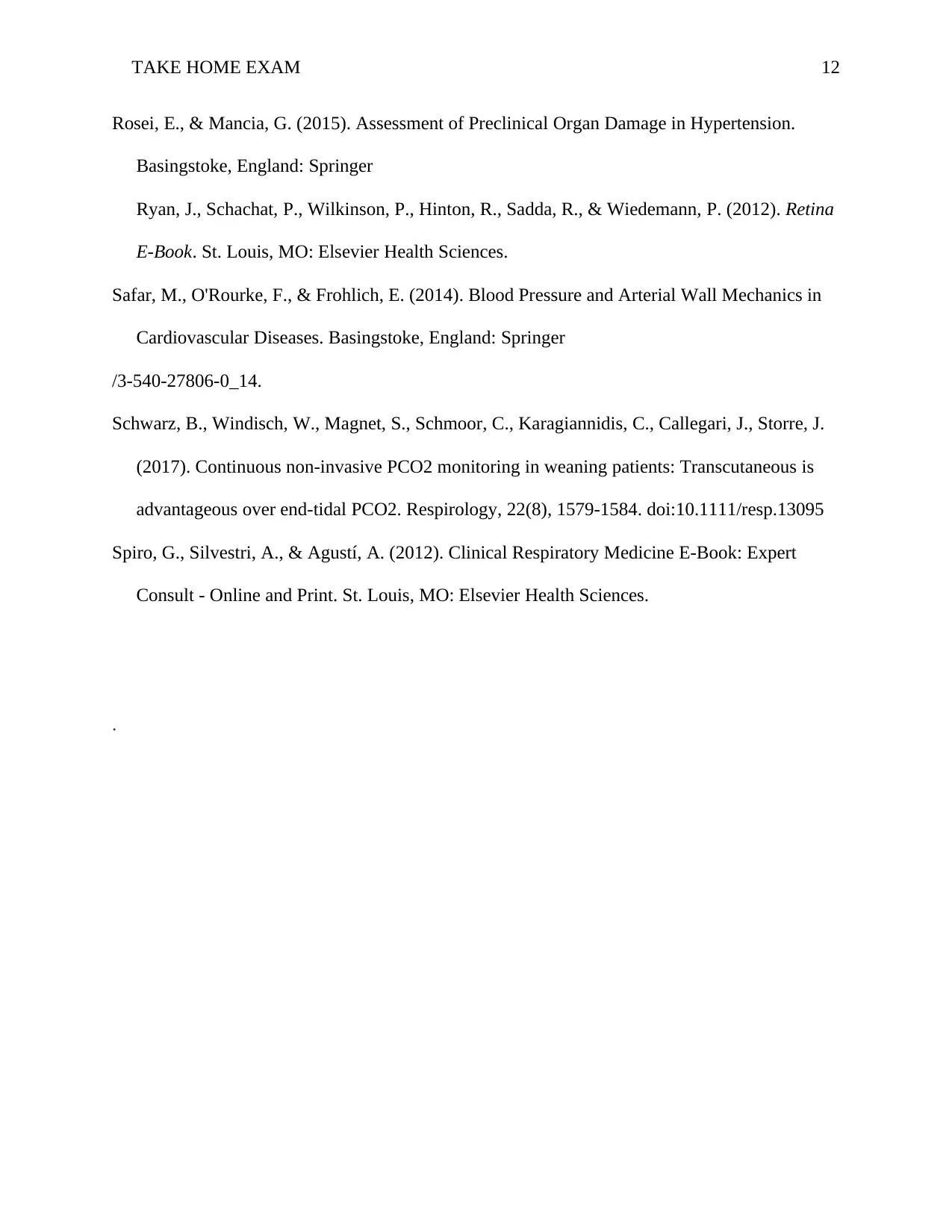
TAKE HOME EXAM 12
Rosei, E., & Mancia, G. (2015). Assessment of Preclinical Organ Damage in Hypertension.
Basingstoke, England: Springer
Ryan, J., Schachat, P., Wilkinson, P., Hinton, R., Sadda, R., & Wiedemann, P. (2012). Retina
E-Book. St. Louis, MO: Elsevier Health Sciences.
Safar, M., O'Rourke, F., & Frohlich, E. (2014). Blood Pressure and Arterial Wall Mechanics in
Cardiovascular Diseases. Basingstoke, England: Springer
/3-540-27806-0_14.
Schwarz, B., Windisch, W., Magnet, S., Schmoor, C., Karagiannidis, C., Callegari, J., Storre, J.
(2017). Continuous non-invasive PCO2 monitoring in weaning patients: Transcutaneous is
advantageous over end-tidal PCO2. Respirology, 22(8), 1579-1584. doi:10.1111/resp.13095
Spiro, G., Silvestri, A., & Agustí, A. (2012). Clinical Respiratory Medicine E-Book: Expert
Consult - Online and Print. St. Louis, MO: Elsevier Health Sciences.
.
Rosei, E., & Mancia, G. (2015). Assessment of Preclinical Organ Damage in Hypertension.
Basingstoke, England: Springer
Ryan, J., Schachat, P., Wilkinson, P., Hinton, R., Sadda, R., & Wiedemann, P. (2012). Retina
E-Book. St. Louis, MO: Elsevier Health Sciences.
Safar, M., O'Rourke, F., & Frohlich, E. (2014). Blood Pressure and Arterial Wall Mechanics in
Cardiovascular Diseases. Basingstoke, England: Springer
/3-540-27806-0_14.
Schwarz, B., Windisch, W., Magnet, S., Schmoor, C., Karagiannidis, C., Callegari, J., Storre, J.
(2017). Continuous non-invasive PCO2 monitoring in weaning patients: Transcutaneous is
advantageous over end-tidal PCO2. Respirology, 22(8), 1579-1584. doi:10.1111/resp.13095
Spiro, G., Silvestri, A., & Agustí, A. (2012). Clinical Respiratory Medicine E-Book: Expert
Consult - Online and Print. St. Louis, MO: Elsevier Health Sciences.
.
1 out of 12
Related Documents
Your All-in-One AI-Powered Toolkit for Academic Success.
+13062052269
info@desklib.com
Available 24*7 on WhatsApp / Email
![[object Object]](/_next/static/media/star-bottom.7253800d.svg)
Unlock your academic potential
© 2024 | Zucol Services PVT LTD | All rights reserved.





